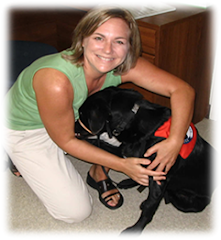
Therapy Dogs are considered working dogs, just as a service dog is considered a working dog. However, there are very distinct differences in access to public areas for the two classes of working dogs. Access laws only grant service dogs the ability to full public access. Therapy dogs do not have this access. For therapy dogs, the facility in which they are visiting must grant that team access to specific areas (designated by the facility). For this reason, therapy dog teams must wear proper identification to demonstrate they have been granted access to a facility. Again, therapy dogs DO NOT have the same access rights that service dogs to.
It's very important when working with a therapy dog that you show proper identification for yourself and the dog. This provides the facility and families with information that your team is properly credentialed to be working in that environment. When a dog is in training, it is also important to notify others of the dog's status. At Jumpstart Therapies, our dogs, even those in training, wear vests identifying them as either a "Therapy Dog in Training" or a "Therapy Dog". Since Jumpstart Therapies is affiliated with Delta Society's Pet Partners program, (www.deltasociety.org) once a dog is registered as a Pet Partner, they will be required to wear a Pet Partners vest when working. For dogs in training, we have found these vests at Active Dogs on the Internet. (www.activedogs.com).
There is a definite difference between a dog in training and a registered therapy dog. Expectations for behavior are similar but with a dog in training. Dogs in either situation are expected to maintain an obedient and respectful attitude toward their handler and people with whom they interact. They are also expected to demonstrate self control in distracting situations, as a registered therapy dog would be expected to do. However, with a dog in training, there is the added knowledge that the dog is learning how to respond to different situations and that lapses do occur. In neither situation, should the dog act or react aggressively toward another dog or person. In all situations, the dog is continuously being evaluated for reactions and predictability.
As I work with Chief, I am learning more and more about how he will potentially respond in certain situations. If there is something I know is challenging for him, it is my role as the handler and trainer to provide opportunity for Chief to work through "scary" situations or to avoid the potential for a negative response to occur. Whenever possible, I try to guide Chief through uncertain situations with lots of positive reinforcement, calm, and reassurance. Chief, as I have mentioned before, is a very bright boy. He quickly learns, when guided, that things that once seemed so scary were, in fact, not.



No comments:
Post a Comment